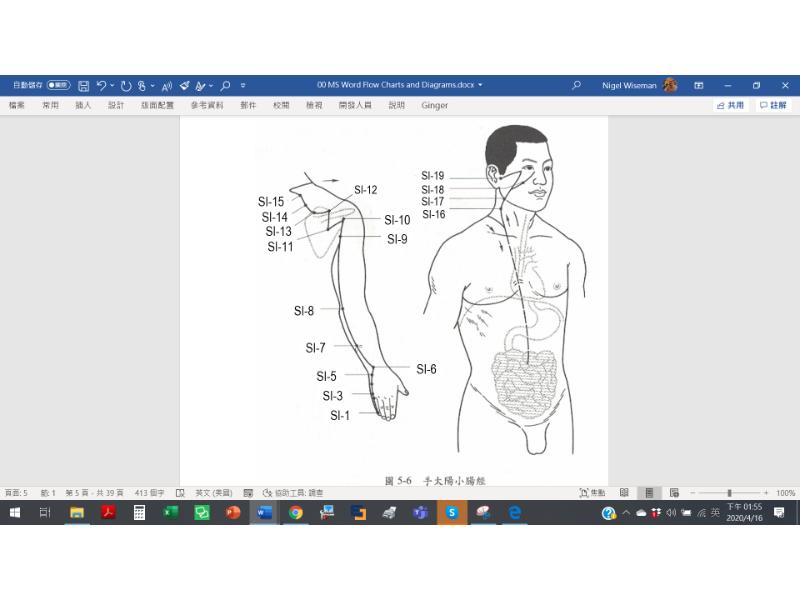Search in dictionary
Hand greater yáng (tài yáng) small intestine channel
手太阳小肠经 〔手太陽小腸經〕 shǒu tài yáng xiǎo chǎng jīng 🔗
Abbreviation: SI. One of the twelve channels.
 |
| Hand greater yáng (tài yáng) small intestine channel |
|---|
Connections
HT → SI → BL; homes to the small intestine; nets the heart.
Small Intestine Channel Pathway
Overview
Lateral tip of little finger → posterior extensor aspect of upper limb → back of shoulder joint → scapula (shoulder blade) → supraclavicular fossa ð- Submerges at supraclavicular fossa → nets the heart → stomach → homes to the small intestine.
- Branch (1): Supraclavicular fossa → the neck → cheek → outer canthus → the ear.
- Secondary branch (2): cheek → inner canthus → BL channel.
Description
The hand greater yáng (tài yáng) small intestine channel starts on the lateral tip of the little finger (SI-1, shào zé, Lesser Marsh) and travels along the ulnar side of the hand to the wrist, emerging at the ulnar styloid process. Continuing up the posterior aspect of the ulna, it passes between the olecranon of the ulna and the medial epicondyle of the humerus on the medial side of the elbow. It ascends the posteromedial side of the upper arm to the back of the shoulder joint. It then meanders across the upper part of the scapula. Above the scapula, it intersects with the governing (dū) vessel at GV-14 (dà zhuī, Great Hammer), before passing over the shoulder close to the neck and turning downward into the supraclavicular fossa.
At the supraclavicular fossa, it submerges, nets the heart, and follows the esophagus down through the diaphragm to the stomach. It then intersects with the controlling (rèn) vessel internally at CV-13 (shàng wǎn, Upper Stomach Duct) and CV-12 (zhōng wǎn, Center Stomach Duct) before homing to the small intestine.
A branch (1) separating at the supraclavicular fossa ascends the neck to the cheek and then travels to the outer canthus of the eye, where it meets the foot lesser yáng (shào yáng) gallbladder channel at GB-1 (tóng zǐ liáo, Pupil Bone-Hole). It then turns back across the temple to enter the ear at SI-19 (tīng gōng, Auditory Palace).
A secondary branch (2) parts from the former branch on the cheek, rises to the infraorbital region, and continues to the inner canthus, where it meets the foot greater yáng (tài yáng) bladder channel at BL-1 (jīng míng, Bright Eyes).
Small Intestine Channel Acupoints
Indications of SI channel Acupoints
The 19 points on the hand greater yáng (tài yáng) small intestine channel treat diseases of head, nape, ears, eyes, throat, spirit-mind, and other problems associated with the course of the channel.
- Head, eyes, ears, mouth, throat: Headache; dizziness; red eyes; eye screens; tinnitus and deafness, toothache, sore throat; mammary welling-abscess (rǔ yōng); scant breast milk.
- Musculoskeletal: Stiff nape; shoulder and scapula pain; pain in the posteromedial face of the arm and shoulder; wrist pain; lumbar and back pain.
Major SI Acupoints
| Indications for SI Points |
|---|
|
SI-1 (少泽 shào zé, Lesser Marsh): Located a little more than 1 fēn below the base of the nail on the ulnar side of the little finger.
- Indications: Headache; eye screens; painful swollen throat; febrile disease; clouding reversal (loss of consciousness); mammary welling-abscess (rǔ yōng); scant breast milk.
- Stimulus: Needling: 0.1 cùn slightly upward oblique insertion. Moxa: 1–3 cones; pole 5–10 min.
- Categories: Well (jǐng) (metal) point.
SI-2 (前谷 qián gǔ, Front Valley): Located on the ulnar aspect of the little finger, slightly distal to the metacarpophalangeal (mcp) joint, at the border of the red and white flesh.
- Indications: Headache; eye pain; tinnitus; painful swollen throat; febrile disease; scant breast milk.
- Stimulus: Needling: 0.1–0.3 cùn perpendicular insertion. Moxa: 1–3 cones; pole 5–10 min.
- Categories: Spring (yíng) (water) point.
SI-3 (后溪 hòu xī, Back Ravine): Located on the ulnar aspect of the hand, proximal to the head of the fifth metacarpal bone, at the border of the red and white flesh.
- Indications: Headache; stiff nape; red eyes; deafness; febrile disease; mania and withdrawal; epilepsy; back pain; lumbar pain; malarial disease; hypertonicity of the elbow, arm, and fingers.
- Stimulus: Needling: 0.3–0.7 cùn perpendicular insertion. Moxa: 1–3 cones; pole 5–15 min.
- Categories: Stream (shù) (wood) point; confluence point (bā mài jiāo huì xué) of the governing vessel.
SI-5 (阳谷 yáng gǔ, Yáng Valley): Located on the ulnar aspect of the wrist, in the depression between the triquetral bone and the ulnar styloid process.
- Indications: Headache; dizzy vision; deafness; tinnitus; febrile disease; mania and withdrawal; epilepsy; hypertonicity of the fingers; wrist pain.
- Stimulus: Needling: 0.2–0.4 cùn perpendicular insertion. Moxa: 3 cones; pole 5–20 min.
- Categories: River (jīng) (fire) point.